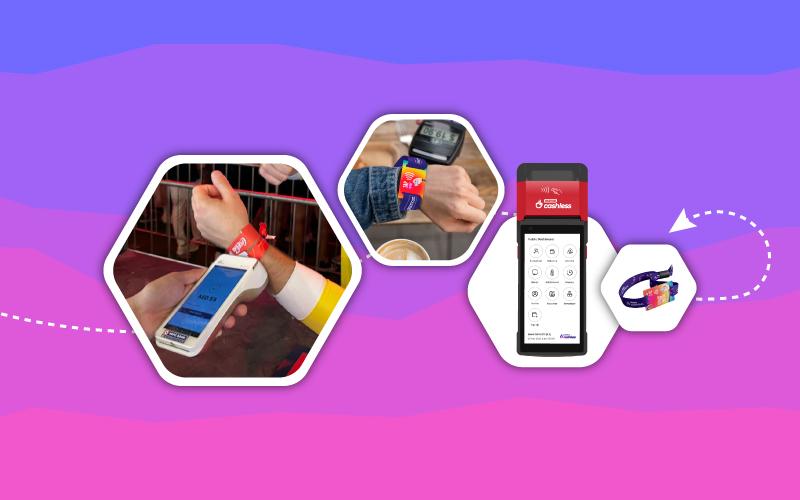When people think about events, they often imagine the lights, music, or maybe the food stalls. But for those who plan events, a lot is going on behind the scenes. From staff coordination to crowd control and payment systems, everything must run smoothly. If you’re an event organizer, one thing that can make your job much easier is using a cashless payment system for events.
Let’s talk about how this works—and why it's making such a big difference at concerts, conferences, food festivals, and even local community events.
The old way: Long lines, slow payments
Imagine this: guests are having a good time, but then they head over to buy a drink or a snack. They pull out cash, but the vendor is scrambling to give change. Card readers are lagging. And the line behind them just keeps getting longer. That delay affects not just the customer’s mood but also the vendor’s sales.
Now imagine if every guest had a digital wristband or card. A quick scan—and it’s paid. No coins. No receipts. No waiting. That’s the promise of a cashless payment system for events.
What is a cashless payment system for events?
Simply put, it's a system that removes physical money from the event experience. Instead, guests load funds onto a digital platform. It could be a wristband, card, or even a mobile barcode. They just scan it at food stalls, merchandise booths, or drink counters to pay instantly.
These systems are powered by cashless payment solutions for events, which can include RFID technology, QR codes, or barcodes.
One common tool being used more now is barcodes for event cashless payments. These barcodes are either printed or displayed on a guest’s phone. Vendors scan them to process payments quickly.
Why organizers are moving to cashless systems
- Faster transactions = happier guests
Nobody wants to wait in line, especially not at a live show or sports event. A good cashless system cuts transaction time down to just a second or two. That means less queuing, more buying, and better guest experience.
- Increased sales and better spend tracking
When paying is easy, people tend to spend more. Studies have shown that cashless users often spend up to 20% more at events compared to those using cash. Plus, organizers get real-time reports on spending patterns, peak times, and best-selling items.
- Less cash handling means fewer mistakes
Cash payments are messy. Staff must count change, manage tills, and handle refunds. Mistakes happen. Cashless systems reduce those errors because everything is digital. Staff don’t need to be trained on handling money, just scanning wristbands or barcodes.
Real-life scenario: Food truck festival goes cashless
Take a small-town food truck festival as an example. In previous years, vendors handled cash, credit cards, and even apps. Some didn’t have working internet for the card readers. Guests got frustrated with delays.
Last year, the organizer rolled out a cashless payment solution for events using RFID wristbands. Guests loaded money online before arriving. Vendors had scanners ready. The result? 40% faster lines, 25% more spending per guest, and no reported theft or cash loss.
It wasn’t perfect. Some guests were unsure how to load funds at first. But staff helped them out, and by the second day, everyone was used to it.
The role of barcodes in cashless payments
Not every event can afford RFID systems. That’s where barcodes for event cashless payments come in handy.
Barcodes are cheap and easy to implement. They can be printed on badges, tickets, or even emailed to guests. A quick scan at the booth lets guests pay instantly. It works well for events like conferences or meetups where high-tech options may not be practical.
And if you're using a smartphone-based system, guests can use the barcode on their mobile device. It’s one of the most flexible and cost-effective ways to go cashless.
What you’ll need to set it up
Starting with a cashless payment system for events doesn’t have to be overwhelming. Here’s a basic checklist:
- A payment platform (RFID, barcode, or QR code-based)
- Wristbands, cards, or digital tickets for guests
- Scanners or mobile devices for vendors
- A top-up station (optional, but helpful for guests who didn’t pre-load funds)
- Staff training
Also, it’s smart to offer a refund option for the leftover balance after the event. This builds trust and keeps guests happy.
Tips to make the switch smooth
Start small: Test your cashless system at a smaller event before using it on a larger scale.
- Educate your audience: Use emails, signs, and social posts to explain how the system works.
- Train your team: Everyone from gate staff to food vendors should know how to operate scanners and handle questions.
- Offer support onsite: Have a help desk or info booth where guests can ask about top-ups or lost wristbands.
- Keep a backup plan: Technology can glitch. Always have a way to manually resolve payment issues if scanners go down.
Is it worth it?
Many organizers ask if switching to a cashless payment solution for events is worth the cost and setup. The answer? Usually, yes. Not only does it make the event run smoother, but it also gives you data. You can see what worked, what didn’t, and what people loved buying.
Plus, you cut down on theft, staff mistakes, and payment delays. It’s good for your bottom line and better for the guest.
Final thoughts
Going cashless isn’t just for big music festivals anymore. Even small events can benefit from it. Whether you’re using high-end RFID wristbands or simple barcodes for event cashless payments, the goal is the same: make spending easier, faster, and safer.
For organizers, it’s less stress and more control. For guests, it’s more fun and less waiting around. And if you’ve ever managed a long payment queue during peak hours, you know—anything that makes things smoother is worth a try.
